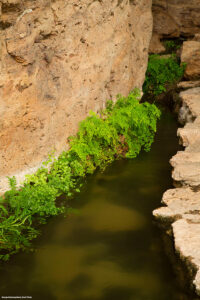The Pima Canals: A Solution for Modern Water Problems in the Southwest
As early as the 1600s, Spanish missionaries considered the Pima people in southern Arizona as the gardeners of the dry American Southwest. The Pima used canals dug by their ancestors to water their fields of wheat, corn, beans, and fruit trees. That is, until American settlers upstream diverted the water of the Gila River, which had nourished the Pima lands. These gardens then became a desert, and the Pima faced starvation for many decades. All that has changed due to long-awaited and hard-won legislation, which has granted the Pima their historical water rights. Today, the Pima and Maricopa peoples are building new canals. Modern irrigation and conservation technologies have turned the desert back into thriving farms of Pima tradition.
Ancient Canal Builders

About 14,000 Akimel O’otham (Pima) and Pee-Posh (Maricopa) people live in the Gila River Indian Community, a reservation south of Phoenix, Arizona. The reservation covers about 585 square miles. The Pima’s ancestors, known as the Huhugam people, lived along the Gila and Salt Rivers from around 300 B.C.E. to 1450 C.E. A great agricultural society, the Huhugam dug more than 500 miles of strategically placed canals. These connected the rivers to smaller channels and ditches alongside fields. Many of the canals were 8–10 feet deep and 25–30 feet across. This irrigation system allowed the Huhugam to grow maize, beans, and squash in the desert—enough to feed up to 60,000 people at the height of their civilization. A mystery surrounds why the Huhugam then disappeared. But the collapse of their society resulted in many canals becoming lost beneath sand and dirt.
Loss of Water
Four centuries later, thousands of American settlers crossed Arizona in the 1850s to reach California’s gold fields. They were aided by the Pima and Maricopa, who were known as the “Good Samaritans of the desert.” Although they had smaller farms than their ancestors, the Pima and Maricopa continued to use Huhugam canals to cultivate more than 14,000 acres of cropland. They profited from their surplus wheat during the American Civil War. Settlers noticed how fertile the land was. Thousands moved into Arizona after Congress passed the Desert Land Act in 1877. This act gave homesteaders 640 acres—if they could improve the land. They did this by diverting water from the Gila River into their own canals. The Pima, assuming they had first claim to the water since they had long used it to improve the land, did not file claims.
Within three years, the water in the Gila River slowed drastically. Many Pima moved away from the reservation. In 1889, the last of the Gila River’s waters were diverted by the Florence Canal Company, which sold the water to non-native farmers. The lack of water caused mass famine and starvation until the 1920s. With no farms or jobs, the poverty-stricken Pima accepted canned goods from the government. A dependency on these processed foods led to diseases, especially diabetes.
The Fight for Water
Beginning in the 1920s, the Pima lodged several lawsuits to regain water rights to the Gila and Salt Rivers. But without money, the legal fight was unsuccessful. Then in 1994, the Pima opened the first casino on their reservation—and revenue increased. Now they had the necessary funds to make a serious legal case for their rights to the Gila and Salt Rivers.
Finally, in 2004—more than 100 years after their rivers were diverted—the Arizona Water Settlements Act gave the Pima and Maricopa the rights to 653,500 acre-feet of water per year. This was the largest water settlement in U.S. history for Native Americans. The Act also provided federal funds totaling $850 million to the Gila River Indian Community for a new irrigation system.
New Canals and Conservation Efforts
The Pima-Maricopa Irrigation Project began in 2009. It has built about 210 miles of main canals. Another 250 miles of smaller channels will soon provide irrigation to individual farms. Unlike the Huhugam, who carved their canals with wood and stone tools, the Pima utilize heavy machinery, concrete, underground pipelines, and laser-precision tools to ensure a steady flow with minimal evaporation. Using their Smartphones, Pima farmers can request a faster or slower flow as needed. Large-scale farms grow wheat, alfalfa, cotton, and other cash crops. Some farmers have reintroduced heritage crops better suited to traditional Pima cuisine.
Like the Huhugam, the Pima respect their water. In April 2023, the Gila River Indian Community signed an agreement to conserve water in the Colorado River basin, which provides drinking water for 1 in 10 Americans. In exchange for $233 million, the Pima will build pipelines to transfer some of their water, put solar panels over their irrigation canals, and create other conservation projects.
